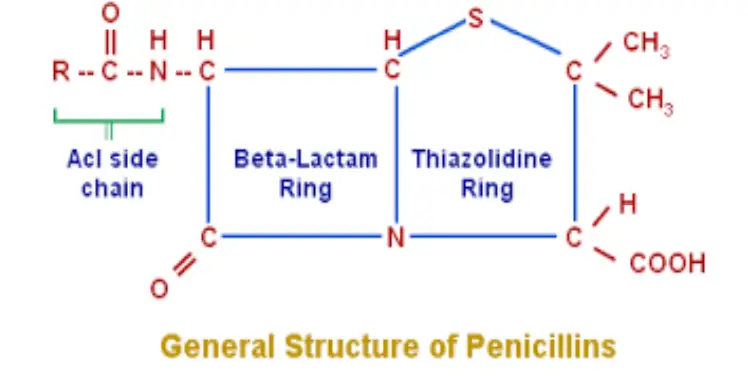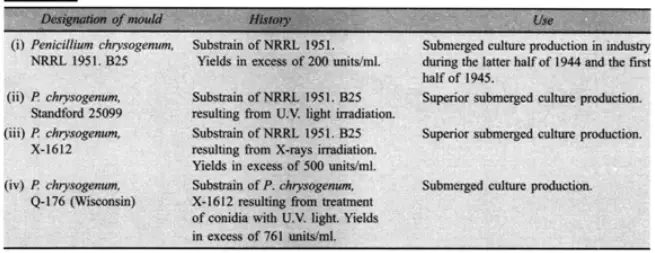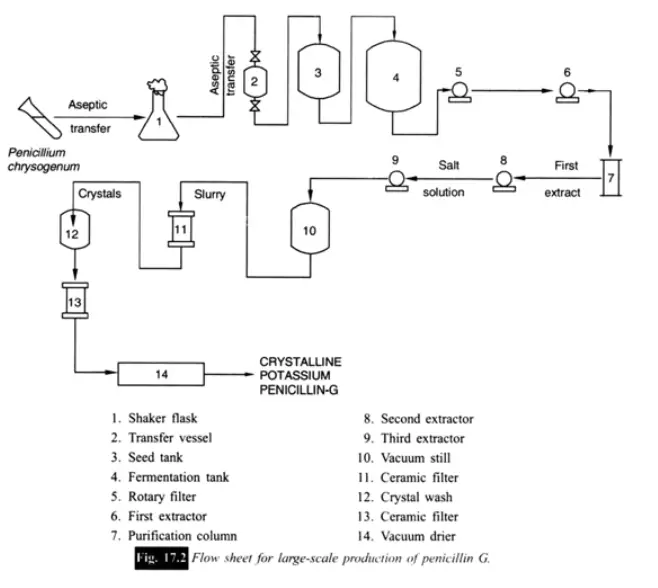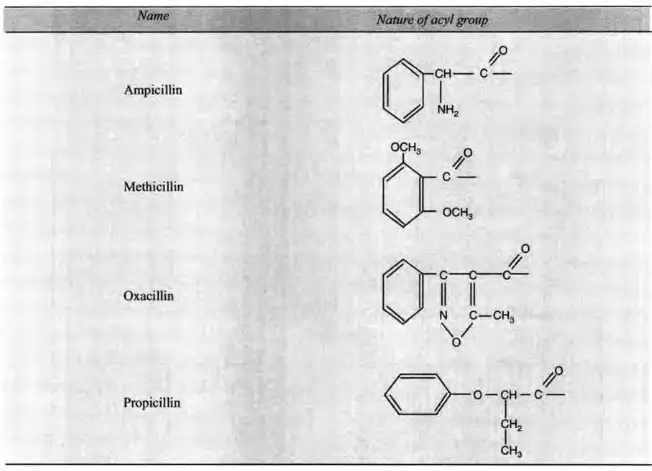In 1929, Alexander Flemming found that the mould Penicillium notatum secreted penicillin. However, the lytic agent appeared to be too unstable to be useful. In 1939, however, when Chain refined the active ingredient, termed penicillin, it proved to be extraordinarily powerful against some illnesses. Penicillin is not a single chemical entity, but rather a series of structurally and functionally similar substances. Penicillin G (benzylpenicillin), penicillin V (phenoxy-methyl penicillin), penicillin F (A2-pentenyl penicillin), penicillin X (p-hydroxybenzyl penicillin), penicillin K (n-heptyl penicillin), and penicillin O are the six penicillins (allyl-mercaptomethyl penicillin). Gram-positive bacteria, certain spirochaetes, and gram-negative diplococci are resistant to penicillin (Neisseria).
Contents
Structure of Penicillin
- The fundamental structure of penicillin is a condensed thiazolidine and B-lactam ring.
- Natural penicillin is 6-amino-penicillinic acid (6 APA).

Production of Penicillin
The Mould
- Utilizing a high-yielding strain in the production of an antibiotic is extremely desirable. This is possible through Sequential genetic selection. In other words, such a strain can be generated through a sequence of mutagenic treatments, each of which is followed by the selection of enhanced mutants.
- This mutant has a significantly larger antibiotic manufacturing capacity than the ‘wild’ strain.
- For the commercial manufacturing of penicillin, high-yielding strains have been produced from the ancestral fungus Penicillium chrysogenum.
- It was discovered that high-yielding Penicillium chrysogenum strains are genetically unstable (in fact, the higher the yield capacity, the more unstable the strain is). Consequently, they are meticulously maintained.
- Production strains are preserved in a dormant state using any of the following standard techniques:
- A spore suspension can be combined with a sterile, finely split inert support (traditionally earth or sand) and dried.
- Spore suspensions can be lyophilized in suitable medium; spore suspensions can be frozen, or preserved under liquid nitrogen.
- All manipulations are performed in laminar flow cabinets in rooms where filtered air is kept at a modest positive pressure relative to the surrounding environment.
- Personnel wear sterile attire and practise aseptic technique with care. In antibiotic fermentations, a pure culture is a rigorous requirement.
- This fact was initially discovered during the manufacturing of penicillin. Many bacteria, such as Staphylococcus aureus, produce the penicillinase enzyme.
- This results in the formation of penicilloic acid by catalysing the hydrolysis of the four-membered p-lactam ring of penicillin.
- Therefore, contamination of a fermentation medium with microorganisms that produce penicillinase can lead to the complete destruction of the accumulated penicillin.

Inoculum preparation

- The objective is to cultivate a pure inoculum in sufficient quantity and rapid growth phase for the production fermentor. Figure depicts a typical inoculum preparation procedure.
- The number of days required to complete each phase reduces as the sequence advances. The medium is designed to supply all the necessary nutrients to the organism.
- Numerous sporulation medium have been designed to produce enormous quantities of spores. Moyer and Coghill (1946a), for example, offered the following sporulation medium:
- The medium described above can be solidified by adding at least 15-25 grammes of agar per litre. A sufficient amount of oxygen is delivered as sterile air. Moreover, the temperature (24°C) is regulated

- Principal requirements for passage to the subsequent level include:
- freedom from contamination
- growth to a predetermined cell density
- Contamination in the inoculum tanks is evaluated using both microscopic inspections and broth medium subcultures.
- The volume of culture grows by nearly a factor of ten at each succeeding stage. The mould, P. chrysogenum, has a filamentous growth pattern.
Inoculation methods
Any of the following may be used to inoculate the fermentation media in the submerged culture synthesis of penicillin:
- It is possible to seed the fermentation medium using dry spores.
- A suspension of mould spores that have not yet germinated can be used to inoculate the fermentation substrate. A non-toxic wetting agent (e.g., sodium lauryl sulfonate diluted 1:10,000 in sterile water) is added to sterile water to create a more homogeneous suspension than is possible with sterile water alone. This suspension may be applied using an appropriate method (e.g. spray guns, pipettes and other means). This is followed by agitation and aeration of the fermentation medium to ensure that the spore suspension is evenly distributed.
- The substrate for fermentation can be seeded with pellet inocula generated by spore germination and mycelial growth under submerged circumstances. After the medium has been seeded with spores, it is normal practise to seed the medium with pellets two or three days later. Utilizing pellets expedites the production cycle.
Raw materials
Consider three factors when selecting raw materials for the production of penicillin:
- a prodigious growth of mycelium.
- maximum penicillin accumulation.
- simplicity of antibiotic extraction and purification
Carbon sources
- Lactose performs admirably as a carbon compound, provided that it is utilised at a concentration of 6%.
- Other carbohydrates, such as glucose and sucrose, can be used as suitable substitutes for lactose if feeding rates are slowed down.
- Glycerol and sorbitol are less appropriate for this application.
Nitrogen sources
- As nitrogenous chemicals, ammonium sulphate, ammonium acetate, ammonium lactate, and other substances may be utilised.
- Typically, nitrogen is provided as ammonia gas. In addition to providing inexpensive and readily accessible nitrogen, corn-based alcoholic beverages are also a source of this element.
Mineral sources
- Numerous specialists have investigated the mineral needs for mould development and subsequent penicillin accumulation. The reports of Pratt (1945), Moyer and Coghill (1946a, b), Hosler and Johnson (1953), and others, are included.
- Potassium, phosphorus, magnesium, sulphur, zinc, and copper are required for the manufacture of penicillin.
- Some of these are provided by corn whiskey. Typically, potassium and phosphorus are supplied as potassium dihydrogen phosphate, whereas magnesium and sulphur are supplied as magnesium sulphate (MgSO4. 7H2O).
- If iron and copper are needed in the medium, they are often added as sulphates. Moyer and Coghill (1946b) observed that a corn-steep liquor-based fermentation medium does not require the addition of zinc or manganese ions.
- If necessary, they are administered as sulphates. Corn-steep liquor appears to have enough levels of potassium dihydrogen phosphate and magnesium sulphate (MgSO4.7H2O).
- However, these salts may be added to the fermentation medium in minute amounts.
Corn-steep liquor
- Please refer to Chapter 12 for information regarding corn-steeped liquor. According to Moyer and Coghill (1946a, b), the presence of this substance in the medium for fermentation increases penicillin output.
- Foster and his colleagues (1946) observed that the stimulatory effects of corn-steep liquor were attributable in part to derivatives of arginine, histidine, glutamic acid, and potentially phenylacetic acid.
Precursors
- There are numerous penicillin derivatives (e.g. penicillin G, penicillin V, penicillin X, etc.). Penicillin G (benzy1-penicillin) and penicillin V are the most important naturally occurring penicillins (phenoxymethy1-penicillin).
- The addition of phenylacetic acid derivatives can induce the synthesis of a desired penicillin. For instance, if phenylacetic acid (C6H5.CH2. COOH) is present in the fermentation medium, the fungus Penicillium chrysogenum will produce enormous quantities of penicillin G.
- The side-chain of penicillin G is provided by phenylacetic acid (PAA). In the formulation of the fermentation medium, corn-steep liquor serves as a source of phenylacetic acid derivatives.
- However, high concentrations of PAA are poisonous to mould, therefore it cannot be added all at once. The feed tries to provide a constant supply of PAA in the medium without exceeding hazardous levels.
- It is hypothesised that the penicillin nucleus, to which the 6-amino-penicillanic acid (6-APA) side-chain is connected, is produced from the amino acids L-cysteine and valine, as depicted in the accompanying diagram.

- According to Jackson (1958), a typical medium contains the following chemical composition:

Extraction and Purification
This operation consists of three distinct phases:
a. Removal of mycelium
- At the time of harvest, penicillin is found in solution extracellularly, along with a variety of other metabolites and medium components. The initial step is to filter out the mycelium.
- Utilizing a rotary vacuum filter for the filtration of fermented fermentation media. This step is performed under circumstances that prevent contamination of the filtrate by penicillinase-producing microbes, which can result in severe or total antibiotic loss.
b. Countercurrent solvent extraction of penicillin
- The subsequent step is to isolate the penicillin. Countercurrent extraction is the conventional method. Using phosphoric or sulphuric acid, the pH of the filtrate [from stage (a)] is adjusted to 2-2.5.
- At such low pH values, there is a large partition coefficient in favour of certain organic solvents in aqueous solutions (e.g. amyl acetate, butyl acetate or methyl iso-butyl ketone).
- This step must be completed rapidly, as penicillin is extremely unstable at low pH values. For this aim, a Podbielniak countercurrent suivent extractor is used.
- The antibiotic is subsequently extracted back into an aqueous buffer with a pH between 7 and 7.5, with the partition coefficient now substantially favouring the aqueous phase.
- The resultant aqueous solution is acidified once again and extracted using an organic solvent.
- These transitions between water and solvent aid in the penicillin’s purification. The wasted solvent is collected for reuse by distillation.
c. Treatment of crude extract
- Penicillin is synthesised as various salts based on its intended application (administration to people and/or animals, for example).
- Depending on the purpose, the treatment of the crude penicillin extract varies, but always entails the creation of an appropriate penicillin salt (usually sodium penicillin).
- The solvent extract as finally secured in stage (b) is extracted again with sodium hydroxide solution. This is likely to be followed by a charcoal treatment to remove pyrogens (fever-causing chemicals) and then sterilisation (e.g. by the use of Seitz filter to remove any bacteria).
- If required, pure metal salts of penicillin can be safely sterilised using dry heat. The penicillin aqueous solution is next subjected to crystallisation.
- The antibiotic is packaged in sterile vials as a powder (for reconstitution before to use) or solution for parental administration. For oral administration, tablets with a film coating are typically used.
- On a significant number of random samples of the final product, exhaustive tests (such as those for potency, purity, absence of pyrogens, and sterility) are undertaken.
- Before being commercialised, it must meet all of the government’s stringent regulations.

Semisynthetic Penicillins
- Semisynthetic penicillins are made from 6-aminopenicillanic acid (6-APA). 6-APA is a kind of penicillin without an acyl group. The 6-APA can be acylated readily and effectively using chemical techniques.
- Thousands of semisynthetic penicillins have been obtained in this manner. In clinical applications, a number of them have proven to be vastly superior to penicillin G.
- The 6-APA is acylated through a chemical reaction with an appropriately activated derivative of a carboxylic acid (most frequently an acid chloride or a mixed anhydride).
- In organic solvents under anhydrous circumstances or in an aqueous solution, the coupling process can be carried out.
- The anhydrous processes are supplemented with organic amines, such as triethyl amine. Alternately, aqueous reactions are commonly conducted in acetone-water solutions containing sodium bicarbonate.
- Typically, the produced semisynthetic penicillins are isolated by distributing the product as its free acid into a water-impermeable organic solvent and the salts and other contaminants into water.
- The table presents the structural formulas of several of the most significant semisynthetic penicillins.












